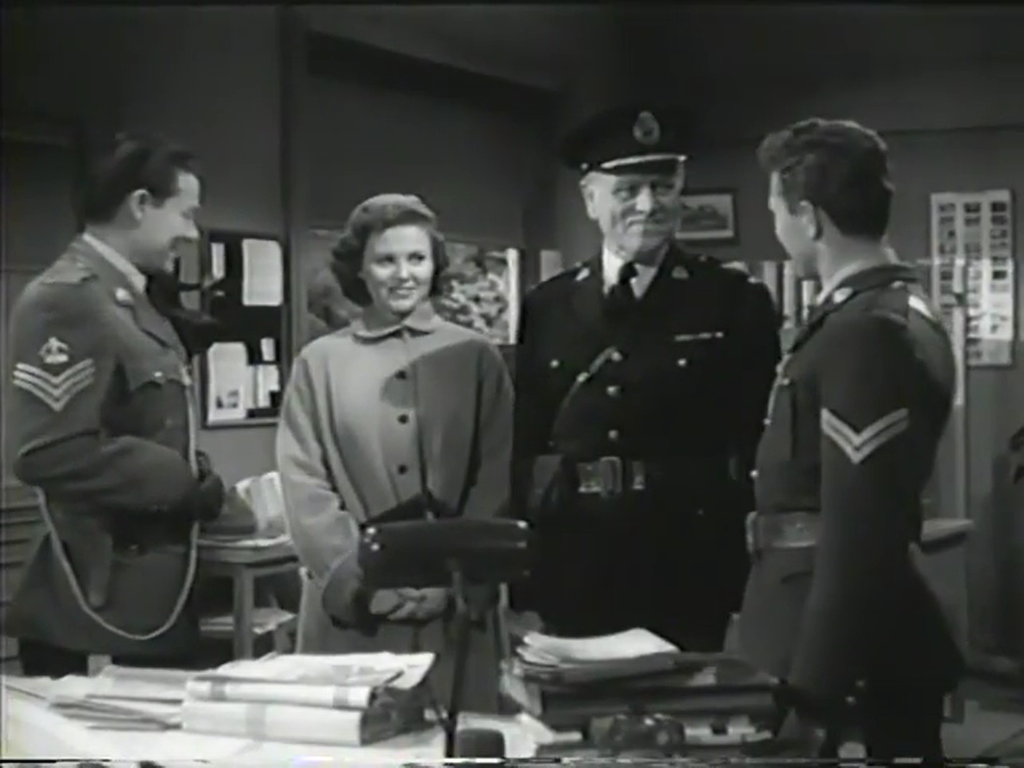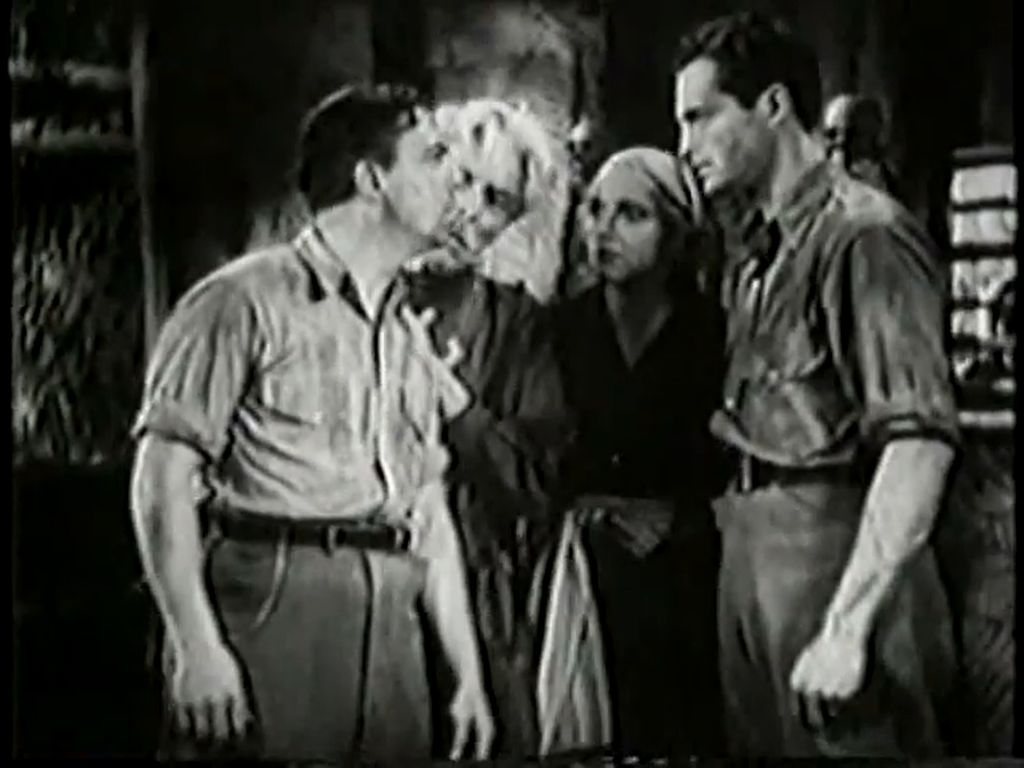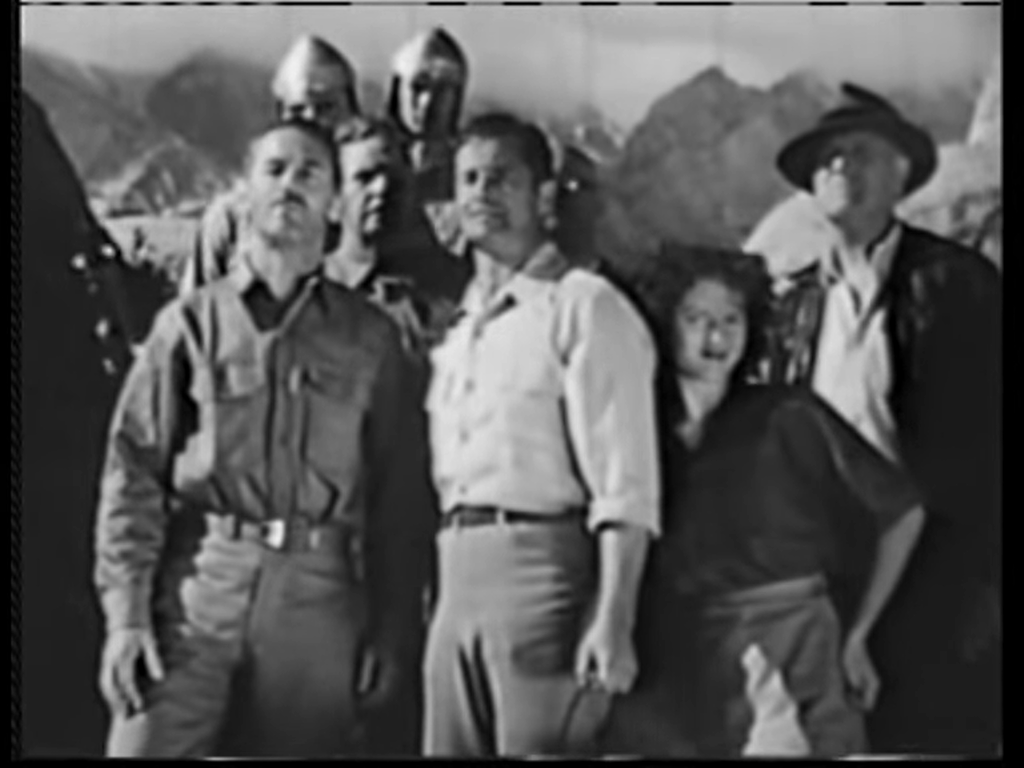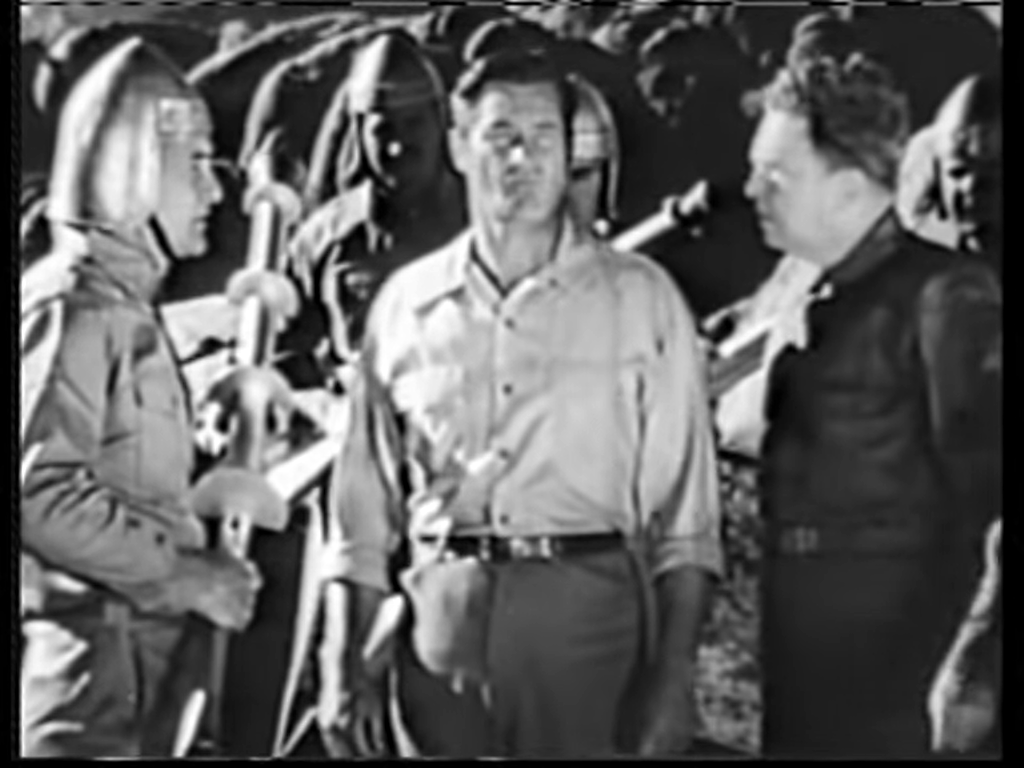-
#384 – Dick Tracy Returns (1938)
Dick Tracy Returns (1938)
Film review #384
Directors: William Witney, John English
SYNOPSIS: F.B.I. G-man Dick Tracy is on the trail of the Stark family: A criminal gang consisting of “Pa Stark” and his five sons. When new G-man recruit Ron Merton is murdered by the Starks when they hijack a convoy, Tracy swears revenge and attempts to track them down while thwarting their many villainous schemes.
THOUGHTS/ANALYSIS: Dick Tracy Returns is a 1938 film serial and the sequel to the Dick Tracy serial released a year earlier. The story this time revolves around Dick Tracy trying to thwart the criminal enterprises of the Stark family criminal gang, led by Papa Stark and his five sons Champ, Trigger, Dude, Kid and Slasher (great names). The Starks have a range of schemes and crimes they try to carry out, and this gives the serial enough variety to see it through, as Tracy and his team have to stop them across land, sea and air, resulting in an array of chases, as well as some good old-fashioned detective work. The original Dick Tracy serial was a strong mix of serial elements that kept its momentum across its fifteen chapters. Dick Tracy Returns emulates that success and continues it. There’s not much new here, but since the original was a success, there isn’t any need to fix what is not broken. And of course, in an era without repeats on television or home media, it was easier to repeat things on screen as the only way to watch these serials was to go to the theatre every week for the next instalment.
Most of the protagonists from the first serial return with the same actors, which provides a good sense of continuity. The only real change is that a different actor plays Junior, but that’s not much of a distraction. There’s not much character development, but every character has a role to play, from the heroic Dick Tracy and Steve Lockwood, the humour from Mike McGurk, and Tracy’s assistant Gwen, there’s a decent amount of variety in the characters. The villains are also fairly interesting, and showing Tracy stop the individual sons of papa Stark makes the story flow a little easier. Like the first serial, Dick Tracy Returns is a good example of the movie serial format, and has plenty of action, distinguishable characters and thrilling cliffhangers to keep viewers coming back. It’s mostly par for the course for the serial format, but a good example of it.
-
#377 – Canadian Mounties vs. Atomic Invaders (1953)
Canadian Mounties vs. Atomic Invaders (1953)
Film review #377
Director: Franklin Adreon
SYNOPSIS: Canadian mountie Don Roberts is teamed up with intelligence operative Kay Conway to investigate reports of spies operating in the area attempting to set up covert missile bases in the Canadian wilderness. Don suspects two members of a group of settlers travelling across the wilderness are working for the spies, and so goes undercover in an attempt to expose them. Meanwhile, Beck and Reed, the spies lackeys, are secretly working to discourage the settlers from travelling to the site where Marloff, the foreign spy, wants to build his missile bases…
THOUGHTS/ANALYSIS: Canadian Mounties vs. Atomic Invaders is a 1953 serial. I think the title alone should grab anyone’s attention, so let’s see if there’s any substance underneath it…
Mountie Don Roberts is visited by his boss and intelligence operative Kay Conway to investigate the presence of foreign spies in the area. They believe that some of the settlers moving through the town are working for the spies, and so Don goes undercover with them to try and uncover their identity and motives. The first part of the serial sees Don travelling through the wilderness with these settlers as he tries to foil the spies schemes. This leads a variety of associated perils such as avalanches, dog-sled chases and other such perils of the wilderness. These sorts of sequences you don’t see too often in these serials of the time, so it is something a little different. The main plot of the serial though is nothing too special, with a constant back-and-forth chase between the heroes and villains. The “atomic invaders” are just plain foreign spies and also not very interesting. In 1953, these kinds of serials were dwindling in number as studios turned towards the feature film (and the b-movie), and the introduction of television would mean that these serials would be viewed at home each week rather than getting people to go to the theatre. With that in mind, the chapters are all (with the exception of the first one) just over thirteen minutes long, which seems a waste of effort going to see such a short film. I suppose a positive of this is that the chapters aren’t drawn out with pointless dialogue and scenes that go nowhere…but that said, there is still plenty of it to fill out the time…
After Don foils Marloff’s (the foreign spy) plans to stop the settlers, the spy changes the location of his proposed missile sites which will destroy the U.S. cities to allow his country to invade with little resistance. This “foreign country” is never mentioned by name, but since the cold war was beginning to get underway at the time, I think it’s fairly obvious which country they are referring to. The rest of the serial involves a more usual set-up of fistfights, car chases and cliff hangers that will be familiar to serial watchers. Again, at this time, the format really had been exhausted, and it can offer no real surprises or originality. Some serials hide the identity of the villain until the very end so as to maintain a sense of intrigue throughout, but this serial does not. It might have been a good idea to keep the identity of Smokey, a village resident who is Marloff in disguise, a secret until the end. Instead, it reveals it almost instantly, and the conflict between the heroes and villains really lacks any dynamic.
Given that the film has a variety of scenes in different locations, there is a lot of stock footage used and shots in the wilderness are cobbled together in a studio with painted backgrounds that look rather unconvincing. The chase scenes in cars and boats look alright, and the explosive cliffhangers have an impact, but the format leaves every twist in the story all too predictable, and despite the bizarre title, Canadian Mounties vs. Atomic Invaders fails to contribute anything unique to a formulaic format.
-
#375 – The Lost City (1935)
The Lost City (1935)
Film review #375
Director: Harry Revier
SYNOPSIS: Extreme weather is causing mass destruction across the Earth, with seemingly no known explanation. Electrical engineer Bruce Gordon manages to use one of his machines to trace the source of these disturbances to an unexplored region of central Africa. He leads an expedition to the area to investigate and ends up discovering a lost city ruled by a madman who is intent on attaining absolute power from his machines. Bruce must join forces with the various people in the region, and stop the evil Zolok from using his machines before the world is destroyed…
THOUGHTS/ANALYSIS: The Lost City is a 1935 science-fiction, twelve part film serial. in the opening, we see storms ravaging the cities of the world, causing mass destruction. The world is unable to find the cause of these freak weather events, until electrical engineer Bruce Gordon uses one of his inventions to locate the source in an unexplored region of central Africa. Bruce leads an expedition to the area withe his friend Jerry Delaney, and when he arrives at a trading post, a man named Butterfield stumbles in injured, telling of a lost city beneath Magnetic Mountain guarded by giants. Believing there is a connection between Magnetic Mountain and the storms, Bruce investigates and finds the lost city is real. There, a man named Zolok is forcing Manyus, a scientist, to construct inventions which he believes will help him rule the world. The opening chapter of the serial is typically full of exciting effects and setting the stage for a thrilling adventure. As I’ve mentioned before in other serial reviews, the opening chapter is often the most thrilling and interesting, as it is meant to entice viewers to return to the theatre every week to watch the subsequent parts. These serials can quite quickly run out of steam, as they are made on a low budget and there is a lot of re-used settings and back-and-forths between the heroes and villains that can get repetitive. With The Lost City though, this repetition is kept to a minimum as there’s a number of distinct locations, and a large cast that gets introduced as the story goes on, so these new elements continually change the dynamic of the plot. Of course, there’s also plenty of daring cliffhangers at the end of each chapter, with lion pens, giant spiders and all sorts of devious traps that will encourage viewers to return next week. The overall story is definitely stronger than many similar serials I have seen.
As I mentioned, the cast is fairly large, and are somewhat diverse. The “giants” are pretty cool, and have a menacing presence. The big problem here though, with the film being set in central Africa, is the film’s depiction of non-white races. The “native tribes” are portrayed as very typical, primitive people as very much stereotypes of what western countries at the time were taught Africa to be. The fact that the film does not further pinpoint the location other than “Africa” again shows how the entire continent is ill-defined by said countries. When the “Arabs” shows up around half-way through the serial, they again are portrayed in a stereotypical fashion. Both of these groups, when they are supposedly speaking in their own language, is clearly just gibberish being shouted by the actors, which again just reinforces the dismissive attitude to non-white cultures. i think the main villain is designed to be similar to an east Asian person as well, just to round off the serial’s inclusion of all races. The portrayal of the black giants is clearly meant to make them as menacing as possible too. On top of all this, there is a plot element that Manyus has invented a medicine that can turn black people white. While the film does not label this as a “cure” for being black, it does feel that way at points, and really just compounds the fact that this film is horrifically outdated, and racially dismissive/ignorant.
The Lost City really shines through in terms of its story, and it paces itself well throughout the twelve chapters by continually introducing new characters and dangers in order to keep things fresh. In this respect, it avoids one of the significant problems that plague the serial format. However, it’s depiction of non-white races is horrifically ignorant and outdated, and really is non-redeemable. Yes, it is a product of it’s time, but I do not feel that it is enough of an excuse to dismiss its harmful racial depictions.
-
#373 – Brick Bradford (1949)
Brick Bradford (1949)
Film review #373
Director: Spencer Gordon Bennet
SYNOPSIS: Brick Bradford and his friends are assigned to visit the lodge of the scientist Doctor Tymak, who has developed “interceptor ray” that can intercept and destroy enemy rockets. It’s potential to be developed into a death ray as well has attracted the attention of the foreign spy Laydron, who wants to steal the ray. Brick and his friends must fight to keep the ray from falling into the wrong hands, and help Tymak finish his research as they travel across time and space to defeat the villainous Laydron and his goons…
THOUGHTS/ANALYSIS: Brick Bradford is a 1949 movie serial based on the comic strips of the same name. The opening introduces Brick Bradford and his friends Sandy Sanderson (yes that is apparently his real name), Professor Salisbury and his daughter Jane. They are visited by a U.N. official to assigns them to aid the work of Doctor Tymak, a scientist working on a secret project who may be the target of foreign spies. The spy Laydron manages to get to Tymak first, and while Tymak flees, Laydron pretends to be him when Brick and his friends get there in order to capture them. The plot of the serial follows the standard serial setups, with a constant back-and-forth between the heroes and villains, fist fights, getting captured, escaping and daring cliffhangers. I suppose what makes the serial unique is that it is a mix of all the usual elements of the format thrown together into one. For example, the opening third deals with Tymak fleeing to the moon after Laydron trying to capture him and Brick going to rescue him. While there, they get caught up in a civil war between a dictator and the rebels who want to restore democracy. This part of the story is very similar (practically identical) to a Flash Gordon serial, and while it will offer no surprises to viewers familiar to said serial, it offers an interesting setting and some fun traps. The next part of the film involves Brick and Sandy going back in time to find a note buried in a treasure chest that has the formula necessary to complete the interceptor ray. They get caught up in a battle between some sailors and a native tribe and the whole setting again offers something different. The third act revolves around the more standard serial plots of kidnapping, fist fights and chases as Laydron tries to get a hold of the interceptor ray. Add to all this the car chase scenes, invisibility devices and convoluted death traps and you’ve got a full-house in movie serial bingo.
The problem with the story is that while it does have plenty of variety, its different parts feel inconsistent with each other. The first part set on the moon is very similar (identical) to a Flash Gordon serial, and is probably the best written part, with a host of identifiable characters and plenty of danger and traps. The second part set in the 18th century is a bit more light-hearted and silly. With Sandy often making plenty of humourous quips. After these adventures throughout space and time, the final part resorts to the typical back-and-forth between the heroes and villains as they chase each other across the few sets the serial has. This is the weakest part of the serial, as it is difficult to top the first two parts. One reason for this disparity is that each part is written by a different writer, and clearly they all have their own ideas of what should be going on in the serial. The director, Spencer Gordon Bennet, did a number of these film serials, but his expertise doesn’t really fix the problems (he also directed the Batman and Robin, serial and after Brick Bradford the Superman serials, which were much better).
The movie serial format is a very outdated format. It’s multiple episodes re-used the same few sets as they were typically constrained to a low budget and would have to stretch what they had as far as possible (yet would keep viewers coming back to the theatre every week to watch the next instalment). Brick Bradford manages to have a good enough variety of settings thanks to the varied story, and is also aided by the fact that there are plenty of outdoor scenes. Obviously the moon having a breathable atmosphere and people living on it is a bit far-fetched today, but would have been somewhat believable back when the serial was released. The “time top” that Brick and Sandy use to travel back through time in is probably one of the first depictions of a time machine on film too, and I can imagine that it sparked people’s imaginations when they saw it for the first time. The characters themselves are all a bit dry and without merit, and Brick doesn’t really stand out alongside the Flash Gordon’s and Buck Rogers’ of the movie world. Overall, Brick Bradford can best be summed up as a “greatest hits” of the sci-fi movie serial: it has everything it needs from death rays, aliens, time travel, invisibility devices, mobs, car chases, convoluted death traps, all-american heroes, and a single female character. However, all of these elements feel very disjointed from one another, and the mix of writers with different perspectives gives the serial an uneven tone. There is a decent amount of variety throughout the fifteen chapters, but by the end the film has exhausted everything the format has to offer and it clearly shows. A valid attempt with familiar concepts, but nowhere near the best that the serial format has to offer.









































